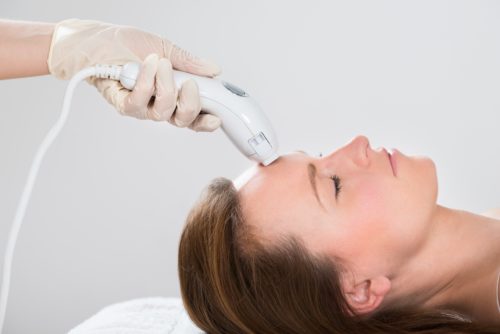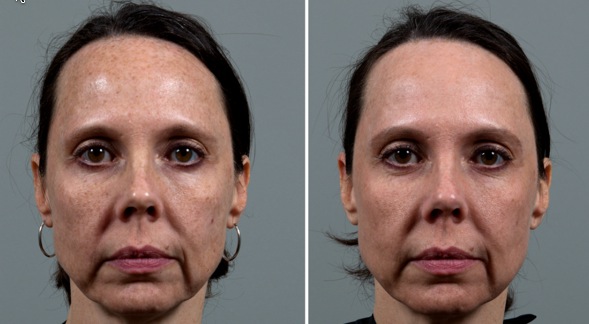Considering an IPL treatment to address sun damage, uneven skin tone, or unwanted hair? While results can be impressive, it’s important to manage expectations. Let’s delve into what you can experience before, during, and after just one IPL treatment. We’ll explore how your skin might react, the potential improvements you might see, and what to do to maximize the benefits.

WHAT IS IPL?
IPL stands for Intense Pulsed Light. It’s a non-surgical treatment that uses pulses of light to target various skin concerns. Unlike lasers that focus on one specific wavelength, IPL delivers a broad spectrum of light. This allows it to address a wider range of issues, such as:
- Uneven skin tone and sun damage
- Age spots and freckles
- Fine lines and wrinkles
- Visible blood vessels
- Unwanted hair growth
KEY BENEFITS OF IPL
IMPROVES SKIN TONE AND TEXTURE
IPL can be used to address a variety of skin concerns, such as sun damage, age spots, freckles, rosacea, and uneven skin tone. The light pulses target melanin, the pigment that gives skin its color, and break it down. This can help to reduce the appearance of brown spots and other discolorations, and leave the skin looking brighter and more even-toned.
REDUCES WRINKLES AND FINE LINES
IPL can also stimulate the production of collagen, a protein that gives skin its structure and elasticity. This can help to reduce the appearance of wrinkles and fine lines, and give the skin a more youthful appearance.
REDUCES UNWANTED HAIR
IPL is a popular option for hair removal. The light pulses target the pigment in hair follicles, which damages the follicle and inhibits hair growth. IPL can be used to remove hair from almost any area of the body, including the face, legs, arms, underarms, and bikini line.
MINIMIZES PORES
IPL can also help to minimize the appearance of enlarged pores. The light pulses stimulate collagen production, which can help to tighten the skin and reduce the appearance of pores.
REDUCES ACNE
IPL can be used to treat acne by targeting the bacteria that cause breakouts. The light pulses also help to reduce inflammation and redness.
BEFORE YOUR TREATMENT
Before undergoing IPL treatment, a consultation with a qualified professional is crucial to ensure optimal results and minimize risks. This initial discussion is vital to set realistic expectations and align your goals with the treatment’s capabilities. The professional will assess your skin type, underlying conditions, and desired outcome to determine if IPL is suitable for you.
In preparation for the treatment itself, the consultation will also address important pre-treatment steps. Sun protection becomes paramount, as tanned skin can react poorly to the light pulses. Tanning beds should be avoided for several weeks beforehand. Certain medications, particularly blood thinners, may also need to be discontinued for a period of time to minimize potential complications during the procedure. By following these pre-treatment measures and openly discussing your goals with a qualified professional, you can ensure a smoother and more successful IPL experience.
DURING YOUR TREATMENT
During the IPL procedure, your safety and comfort are top priorities. Your eyes will be shielded from the light pulses with protective eyewear, similar to what you might wear during a laser treatment. The healthcare professional will then apply a cool gel to the treatment area to numb the skin and act as a protective barrier.
The IPL device itself delivers targeted bursts of light to your skin. While most people tolerate the treatment well, it’s important to acknowledge that you might experience some mild discomfort. This can feel like a snapping sensation or a warm prickling with each light pulse. The intensity can vary depending on your individual skin sensitivity and the settings used during the treatment. However, the discomfort is usually manageable and shouldn’t deter you from the procedure.
AFTER YOUR TREATMENT
Following your IPL treatment, it’s normal to experience some temporary side effects. The treated area may show redness and swelling, similar to a mild sunburn. This discomfort should subside within a few hours or days and can be soothed with cool compresses. You might also feel a temporary sunburned sensation.
While these initial effects may seem concerning, the treatment can also trigger desired long-term changes. Treated spots, like sun damage or freckles, may actually darken temporarily before they flake off and reveal the improved underlying skin. This is a normal part of the process and signifies the treatment is working.
To optimize healing and maximize the benefits of IPL, proper aftercare is essential. Sun protection remains paramount. Apply a broad-spectrum sunscreen with SPF 30 or higher daily, even on cloudy days. Stick to a gentle skincare routine, avoiding harsh soaps or scrubs that could irritate the treated area. Hot showers or baths are also best avoided for at least 24 hours, as they can further aggravate the skin. By following these aftercare tips, you can help your skin heal comfortably and achieve the best possible outcome from your IPL treatment.
IPL RESULTS: BEFORE AND AFTER 1 TREATMENT
IMMEDIATE AFTER-EFFECTS OF IPL TREATMENT
After your first IPL treatment, your skin might feel like you’ve got a sunburn. This feeling should go away in a few hours, but your skin might stay red for a few days. Don’t worry if dark spots look darker right after the treatment—that’s normal and they’ll peel off gently within a few weeks, showing lighter and more even-toned skin underneath.
CHANGES IN SKIN PIGMENTATION AFTER 1 IPL TREATMENT
Your skin might look lighter after just one IPL session, especially dark spots and pigmentation. Big freckles and brown spots might seem lighter right away. But for the best results, it’s usually recommended to have three or more treatments spread out over a few weeks.
CHANGES IN BROKEN CAPILLARIES AFTER 1 IPL TREATMENT
IPL can also help with broken capillaries and rosacea, making redness and flushing less noticeable. After one treatment, you might see fewer broken capillaries, which can give your skin a more even look.
CHANGES IN SKIN TEXTURE AND FINE LINES AFTER 1 IPL TREATMENT
IPL isn’t only about fixing colors—it can also make your skin smoother and reduce fine lines. After your first session, your skin might feel smoother and look more radiant. Fine lines might not be as obvious because IPL helps your skin make more collagen, which keeps it elastic and youthful.
Even though you might notice some good changes after the first treatment, the best results usually come after several treatments. If you have a lot of sun damage, it might take longer and need more than three treatments at first.

Before & After Results from (One) IPL Treatment
FAQ
1. How many treatments will I need?
Multiple treatments are typically needed (often 4-6 sessions) for optimal results, spaced several weeks apart.
2. How long does a treatment take?
Treatment times vary depending on the treated area, but typically range from 15 minutes to an hour.
3. Does IPL hurt?
You might feel a slight tingling or pinching sensation during the treatment, but most clinics offer topical numbing cream to minimize discomfort.
4. When will I see results?
You might see some improvement in skin tone and texture within a few weeks, with full results taking several sessions.
5. How long do IPL results last?
Results can vary, but with proper sun protection, they can last for months or even years.
CONCLUSION
Even strong creams like retinol with vitamin C or tretinoin can’t always fix everything. IPL is a treatment that can help improve your skin’s look in a big way. To get the best results and feel as comfortable as possible during your first IPL session, there are some things to know beforehand. Everyone’s skin is different, so talking to a qualified doctor or healthcare provider who knows about IPL is important. They can help you decide if it’s right for you and create a plan to get the best outcome.




